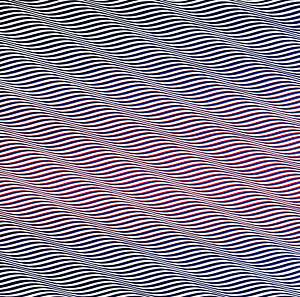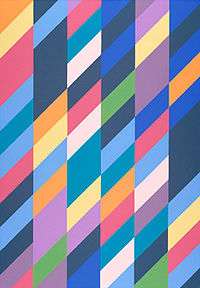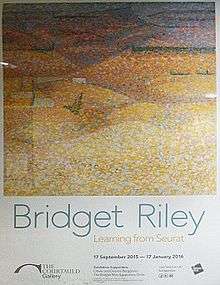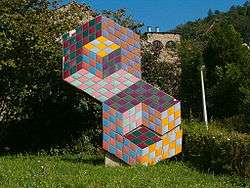Bridget Riley
| Bridget Riley | |
|---|---|
 Movement in Squares, 1961, tempera on hardboard | |
| Born |
Bridget Louise Riley 24 April 1931 Norwood London, England, UK |
| Nationality | British |
| Education | Goldsmiths College, Royal College of Art |
| Known for | Painting and Drawing |
| Movement | Op art |
Bridget Louise Riley CH CBE (born 24 April 1931 in Norwood, London) is an English painter who is one of the foremost exponents of Op art.[1] She currently lives and works in London, Cornwall and the Vaucluse in France.[2]
Early life and education
Riley was born in London in 1931. Her grandfather was an Army officer. Her father, John Fisher Riley, originally from Yorkshire, was a printer. In 1938 he relocated the printing business, together with his family, to Lincolnshire.[3]
At the beginning of World War II Riley's father was mobilised from the Honourable Artillery Company and sent to the Far East. Bridget Riley, together with her mother and sister Sally, moved to a cottage in Cornwall.[4] The cottage, not far from the sea near Padstow, was shared with an aunt who was a former student at Goldsmiths' College, London. Primary education came in the form of irregular talks and lectures by non-qualified or retired teachers.[5] She attended Cheltenham Ladies' College (1946–1948) and then studied art at Goldsmiths College (1949–52), and later at the Royal College of Art (1952–55).[6] There her fellow students included artists Peter Blake, Geoffrey Harcourt (the retired painter, also noted for his many well known chair designs) and Frank Auerbach. In 1955 Riley graduated with a BA degree.
Between 1956 and 1958 she nursed her father, who had been involved in a serious car crash, and herself suffered a breakdown. After this she worked in a glassware shop and also, for a while, taught children. She eventually joined the J. Walter Thompson advertising agency, as an illustrator, where she worked part-time until 1962. The large Whitechapel Gallery exhibition of Jackson Pollock, in the winter of 1958, was to have a major impact on her.[5]
Her early work was figurative with a semi-impressionist style. Between 1958 and 1959 her work at the advertising agency showed her adoption of a style of painting based on the pointillist technique.[7] Around 1960 she began to develop her signature Op Art style consisting of black and white geometric patterns that explore the dynamism of sight and produce a disorienting effect on the eye.[6] In the summer of 1960 she toured Italy with mentor Maurice de Sausmarez, and the two visited the Venice Biennale with its large exhibition of Futurist works.[5]
Early in her career, Riley worked as an art teacher from 1957–58 at the Convent of the Sacred Heart, Harrow (now known as Sacred Heart Language College). Later she worked at the Loughborough School of Art (1959), Hornsey College of Art, and Croydon College of Art (1962–64).
In 1961, with partner Peter Sedgley, she visited the Vaucluse plateau in the South of France, and acquired a derelict farm which would eventually be transformed into a studio. Back in London, in the spring of 1962, Riley was given her first solo exhibition, by Victor Musgrave of Studio One.[5]
In 1968 Riley, with Peter Sedgley and the journalist Peter Townsend, created the artists' organisation SPACE (Space Provision Artistic Cultural and Educational), with the goal of providing artists large and affordable studio space.[8][9]
Work
Riley's mature style, developed during the 1960s, was influenced by a number of sources.[10]

It was during this time that Riley began to paint the black and white works for which she is best known. They present a great variety of geometric forms that produce sensations of movement or colour. In the early 1960s, her works were said to induce sensation in viewers as varied as seasick and sky diving. From 1961 to 1964 she worked with the contrast of black and white, occasionally introducing tonal scales of grey. Works in this style comprised her first 1962 solo show at Musgrave's Gallery One, as well as numerous subsequent shows. For example, in Fall, a single perpendiculars curve is repeated to create a field of varying optical frequencies.[11] Visually, these works relate to many concerns of the period: a perceived need for audience participation (this relates them to the Happenings, for which the period is famous), challenges to the notion of the mind-body duality which led Aldous Huxley to experiment with hallucinogenic drugs; concerns with a tension between a scientific future which might be very beneficial or might lead to a nuclear war; and fears about the loss of genuine individual experience in a Brave New World.[12] Her paintings have, since 1961, been executed by assistants from her own endlessly edited studies.[4]

Riley began investigating colour in 1967, the year in which she produced her first stripe painting.[13] Following a major retrospective in the early 1970s, Riley began travelling extensively. After a trip to Egypt in the early 1980s, where she was inspired by colourful hieroglyphic decoration, Riley began to explore colour and contrast.[14] In some works, lines of colour are used to create a shimmering effect, while in others the canvas is filled with tessellating patterns. Typical of these later colourful works is Shadow Play.
In many works since this period, Riley has employed others to paint the pieces, while she concentrates on the actual design of her work[15] Some are titled after particular dates, others after specific locations (for instance, Les Bassacs, the village near Saint-Saturnin-lès-Apt in the south of France where Riley has a studio).[16]
Following a visit to Egypt in 1980–81 Riley created colours in what she called her 'Egyptian palette'[17] and produced works such as the Ka and Ra series, which capture the spirit of the country, ancient and modern, and reflect the colours of the Egyptian landscape.[7] Invoking the sensorial memory of her travels, the paintings produced between 1980 and 1985 exhibit Riley's free reconstruction of the restricted chromatic palette discovered abroad. In 1983 for the first time in fifteen years, Riley returned to Venice to once again study the paintings that form the basis of European colourism. Towards the end of the 1980s Riley's work underwent a dramatic change with the reintroduction of the diagonal in the form of a sequence of parallelograms used to disrupt and animate the vertical stripes that had characterised her previous paintings.[18] In Delos (1983), for example, blue, turquoise, and emerald hues alternate with rich yellows, reds and white.[19]
Murals
Over the course of her career, Riley has created murals for major art institutions, including the Tate, the Musée d'Art Moderne de la Ville de Paris and the National Gallery, but none were permanent. In 2014, the Imperial College Healthcare Charity Art Collection commissioned the artist to make a permanent 56-meter mural, her first for 27 years, for St Mary's Hospital, London; the work was installed on the 10th floor of the hospital's Queen Elizabeth Queen Mother Wing, joining two others for the 8th and 9th floors completed by Riley more than 20 years earlier.[20]
On the nature and role of the artist
Riley made the following comments regarding artistic work in her lecture Painting Now, 23rd William Townsend Memorial Lecture, Slade School of Fine Art, London, 26 November 1996:[21][22]
Beckett interprets Proust as being convinced that such a text cannot be created or invented but can only be discovered within the artist himself, and that it is, as it were, almost a law of his own nature. It is his most precious possession, and, as Proust explains, the source of his innermost happiness. However, as can be seen from the practice of the great artists, although the text may be strong and durable and able to support a lifetime's work, it cannot be taken for granted and there is no guarantee of permanent possession. It may be mislaid or even lost, and retrieval is very difficult. It may lie dormant, and be discovered late in life after a long struggle, as with Mondrian or Proust himself. Why it should be that some people have this sort of text while others do not, and what 'meaning' it has, is not something which lends itself to argument. Nor is it up to the artist to decide how important it is, or what value it has for other people. To ascertain this is perhaps beyond even the capacities of an artist's own time.
Writer and curator
Riley has written on artists from Nicolas Poussin to Bruce Nauman. She co-curated "Piet Mondrian: From Nature to Abstraction" (with Sean Rainbird) at the Tate Gallery in 1996.[23] Alongside art historian Robert Kudielka, Riley also served as curator of the 2002 exhibition "Paul Klee: The Nature of Creation", an exhibition at the Hayward Gallery in London.[24] In 2010, she curated an artists choice show at the National Gallery in London, choosing large figure paintings by Titian, Veronese, El Greco, Rubens, Poussin, and Paul Cézanne.[25][26]
Exhibitions

In 1965, Riley exhibited in the Museum of Modern Art in New York City show, The Responsive Eye (created by curator William C. Seitz); the exhibition which first drew worldwide attention to her work and the Op Art movement. Her painting Current, 1964, was reproduced on the cover of the show's catalogue. Riley became increasingly disillusioned, however, with the exploitation of her art for commercial purposes, discovering that in the USA there was no copyright protection for artists. The first US copyright legislation was eventually passed, following an independent initiative by New York artists, in 1967.[5]
She participated in documentas IV (1968) and VI (1977). In 1968, Riley represented Great Britain in the Venice Biennale, where she was the first British contemporary painter, and the first woman, to be awarded the International Prize for painting.[13] Her disciplined work lost ground to the assertive gestures of the Neo-Expressionists in the 1980s, but a 1999 show at the Serpentine Gallery of her early paintings triggered a resurgence of interest in her optical experiments. "Bridget Riley: Reconnaissance", an exhibition of paintings from the 1960s and 1970s, was presented at Dia:Chelsea in 2000. In 2001, she participated in Site Santa Fe,[27] and in 2003 the Tate Britain organised a major Riley retrospective. In 2005 her work was featured at Gallery Oldham.[28] Between November 2010 and May 2011 her exhibition "Paintings and Related Work" was presented at the National Gallery, London.
In June and July 2014 the retrospective show "Bridget Riley: The Stripe Paintings 1961–2014" was presented at the David Zwirner Gallery in London.[29][30] In July and August 2015 the retrospective show "Bridget Riley: The Curve Paintings 1961–2014" was presented at the De La Warr Pavilion in Bexhill-on-Sea.[31] From September 2015 to January 2016, the Courtauld Gallery presented "Bridget Riley: Learning from Seurat" in London, illustrating how Georges Seurat's pointillist work The Bridge at Courbevoie influenced her towards abstract painting.[32] In November 2015, the exhibition Bridget Riley opened at David Zwirner in New York. The show features paintings and works on paper by the artist from 1981 to present; the fully illustrated catalogue features an essay by the art historian Richard Shiff and biographical notes compiled by Robert Kudielka.[33]
Public collections
- Abbot Hall Art Gallery, Kendal[34]
- Arts Council Collection, London[34]
- British Council Collection, London[34]
- Ferens Art Gallery, Hull[34]
- Fitzwilliam Museum, Cambridge[34]
- Glasgow Museums Resource Centre, Glasgow[34]
- Government Art Collection, London[34]
- Leeds Art Gallery[34]
- Maclaurin Art Gallery at Rozelle House, Ayr[34]
- Manchester Art Gallery[34]
- Morley College, London[34]
- Museum Boijmans Van Beuningen, Rotterdam[35]
- Museum of Fine Arts, Boston
- Museum of Modern Art, New York
- National Museum Cardiff, National Museum Wales[34]
- Nelson-Atkins Museum of Art, Kansas City
- Ruth Borchard Collection[34]
- Southampton City Art Gallery[34]
- Tate, London[34]
- University of Warwick[34]
- Walker Art Gallery, Liverpool[34]
- Whitworth, Manchester[34]
Artists who have acknowledged Riley's influence on their work include Ross Bleckner, Philip Taaffe, and Diana Thater. In 2013, Riley claimed that a wall-sized, black-and-white checkerboard work by Tobias Rehberger plagiarised her painting Movement of Squares and asked for it to be removed from display at the Berlin State Library's reading room.[36]
Recognition
Riley has been given honorary doctorates by Oxford (1993) and Cambridge (1995). In 2003, she was awarded the Praemium Imperiale,[37] and in 1998 she became one of only 65 Companions of Honour in Britain. As a board member of the National Gallery in the 1980s, she blocked Margaret Thatcher's plan to give an adjoining piece of property over to developers and thus helped ensure the eventual construction of the museum's Sainsbury Wing.[4] Riley has also received the international prize for painting at the 1968 Venice Biennale, the Kaiserring of the city of Goslar in 2009 and the 12th Rubens Prize of Siegen in 2012.[38] Also in 2012, she became the first woman to receive the Sikkens Prize, the Dutch art prize recognising the use of colour.[39]
Art market
In 2006, her Untitled (Diagonal Curve) (1966), a black-and-white canvas of dizzying curves, was bought by Jeffrey Deitch at Sotheby's for $2.1 million, nearly three times its $730,000 high estimate and also a record for the artist.[40] In February 2008, the artist's dotted canvas Static 2 (1966) brought £1,476,500 ($2.9 million), far exceeding its £900,000 ($1.8 million) high estimate, at Christie's in London.[41] Chant 2 (1967), part of the trio shown in the Venice Biennale, went to a private American collector for £2,561,250 ($5.1 million), in July 2008, at Sotheby's.[42]
Riley is represented in London by Karsten Schubert who has been her main agent since 1990,[43] as well as by David Zwirner in London and New York, Max Hetzler in Paris and Berlin, and Green on Red Gallery in Dublin.
Bibliography
- Bridget Riley: The Stripe Paintings 1961–2014 (New York: David Zwirner Books, 2014). Texts by Robert Kudielka, Paul Moorhouse, and Richard Shiff. ISBN 9780989980975 [44]
- Bridget Riley: The Stripe Paintings 1961–2012 (London: Ridinghouse; Berlin: Holzwarth Publications and Galerie Max Hetzler, 2013). Texts by John Elderfield, Robert Kudielka and Paul Moorhouse.[45]
- Bridget Riley: Works 1960–1966 (London: Ridinghouse, 2012). Bridget Riley in conversation with David Sylvester (1967) and with Maurice de Sausmarez (1967).
- Bridget Riley: Complete Prints 1962–2012 (London: Ridinghouse, 2012). Essays by Lynn MacRitchie and Craig Hartley; edited by Karsten Schubert.
- The Eye’s Mind: Bridget Riley. Collected Writings 1965–1999 (London: Thames & Hudson, Serpentine Gallery and De Montfort University, 1999). Includes conversations with Alex Farquharson, Mel Gooding, Vanya Kewley, Robert Kudielka, and David Thompson. Edited by Robert Kudielka.
- Bridget Riley: Paintings from the 60s and 70s (London: Serpentine Gallery, 1999). With texts by Lisa Corrin, Robert Kudielka, and Frances Spalding.
- Bridget Riley: Selected Paintings 1961–1999 (Düsseldorf: Kunstverein für die Rheinlande und Westfalen; Ostfildern: Cantz Publishers, 1999). With texts by Michael Krajewski, Robert Kudielka, Bridget Riley, Raimund Stecker, and conversations with Ernst H. Gombrich and Michael Craig-Martin.
- Bridget Riley: Works 1961–1998 (Kendal, Cumbria: Abbot Hall Art Gallery and Museum, 1998). A conversation with Isabel Carlisle.
- Bridget Riley: Dialogues on Art (London: Zwemmer, 1995). Conversations with Michael Craig-Martin, Andrew Graham Dixon, Ernst H. Gombrich, Neil MacGregor, and Bryan Robertson. Edited by Robert Kudielka and with an introduction by Richard Shone.
- Bridget Riley: Paintings and Related Work (London: National Gallery Company Limited, 2010). Text by Colin Wiggins, Michael Bracewell, Marla Prather and Robert Kudielka. ISBN 978 1 85709 497 8.
References
- ↑ Tate Biography
- ↑ Bridget Riley: Reconnaissance, September 21, 2000 – June 17, 2001 Dia Art Foundation, New York.
- ↑ Olly Payne (2012). "Bridget Riley". op-art.co.uk. Retrieved 1 March 2013.
- 1 2 3 Mary Blume (19 June 2008), Bridget Riley retrospective opens in Paris New York Times.
- 1 2 3 4 5 Kudielka, R., "Chronology" in Bridget Riley: Paintings and Related Work, London: National Gallery Company Limited, 2010, pp. 67–72. ISBN 978 1 85709 497 8.
- 1 2 Chilvers, Ian & Glaves-Smith, John eds., Dictionary of Modern and Contemporary Art, Oxford: Oxford University Press, 2009. pp. 598–599
- 1 2 Bridget Riley Museum of Modern Art, New York.
- ↑ "The SPACE Story" Archived 10 May 2011 at the Wayback Machine.
- ↑ "The Life of Riley"
- ↑ Women Artists in the 20th and 21st Century, By Uta Grosenick, Ilka Becker, Bridget Riley p.450-455. retrieved December 31, 2008
- ↑ Bridget Riley, Fall (1963) Tate.
- ↑ Introduction to Frances Follin, Embodied Visions: Bridget Riley, Op Art and the Sixties, Thames and Hudson 2004
- 1 2 "Press Release: Bridget Riley". Tate Gallery. 17 March 2003. Retrieved 18 September 2015.
- ↑ Things to Enjoy, Bridget Riley, talking to Bryan Robertson in Bridget Riley, Dialogues on Art, p.87
- ↑ Practising Abstraction, Bridget Riley talking to Michael Craig-Martin in Bridget Riley, Dialogues on Art, p.62
- ↑ Karen Rosenberg (21 December 2007), Bridget Riley New York Times.
- ↑ Bridget Riley, Ka 3 (1980) Christie's 20th Century British Art, London, 6 June 2008.
- ↑ Bridget Riley, August (1995) Christie's Post-War & Contemporary Art Evening Sale, London, 30 June 2008.
- ↑ Jörg Heiser (May 2011), Bridget Riley at Galerie Max Hetzler, Berlin, Frieze.
- ↑ Caroline Davies (6 April 2014), Bridget Riley's bold colours boost London hospital ward The Guardian.
- ↑ Bracewell, Michael (October 2008). "Seeing is Believing". Frieze Magazine. Retrieved 15 December 2010.
- ↑ Riley, Bridget (September 1997). "Painting Now". The Burlington Magazine. The Burlington Magazine Publications, Ltd. 139 (1134): 616–622. JSTOR 887465.
- ↑ Bridget Riley The Stripe Paintings 1961–2014, June 13 – July 25, 2014 David Zwirner, London.
- ↑ Alan Riding (10 March 2002), The Other Klee, the One Who's Not on Postcards New York Times.
- ↑ Hilary Spurling (27 November 2010), Bridget Riley at the National Gallery – review The Guardian.
- ↑ Martin Gayford (10 December 2010), Colors Shimmer as Bridget Riley Confronts Old Masters: Review Bloomberg.
- ↑ Christopher Knight (25 November 2000), Seeing the Top of the Op Artists Los Angeles Times.
- ↑ "Tom Bendhem: Collector". Oldham Council. Retrieved 13 January 2013.
- ↑ "The Stripe Paintings 1961–2014". David Zwirner. 25 July 2014. Retrieved 4 March 2015.
- ↑ Wullschlager, Jackie (6 June 2014). "Bridget Riley: a London retrospective". FT.com. Retrieved 4 March 2015.
- ↑ "Bridget Riley: The Curve Paintings 1961–2014". De La Warr Pavilion. 5 August 2015. Retrieved 5 August 2015.
- ↑ "Bridget Riley: Learning from Seurat". The Courtauld Gallery. Retrieved 27 September 2015.
- ↑ "Bridget Riley". David Zwirner Books. Retrieved 6 November 2015.
- 1 2 3 4 5 6 7 8 9 10 11 12 13 14 15 16 17 18 CMS, Keepthinking – Qi. "Art UK | Home". artuk.org. Retrieved 23 May 2016.
- ↑ Collection Museum Boijmans Van Beuningen
- ↑ Julia Michalska (15 January 2014), Agreement reached in plagiarism row between artists Archived 17 January 2014 at the Wayback Machine. The Art Newspaper.
- ↑ Louise Roug (23 October 2003), Five luminaries to receive arts awards Los Angeles Times.
- ↑ "Sikkens Foundation Biography". Retrieved 31 October 2012.
- ↑ "BBC News – Bridget Riley receives Dutch art prize". Bbc.co.uk. 30 October 2012. Retrieved 13 January 2013.
- ↑ Carol Vogel (26 June 2006), Prosperity Sets the Tone at London Auctions New York Times.
- ↑ "Bridget Riley (b. 1931) | Static 2 | POST-WAR & CONTEMPORARY ART Auction | 1960s, Paintings | Christie's". Christies.com. 6 February 2008. Retrieved 7 July 2015.
- ↑
- ↑ "Karsten Schubert". Karsten Schubert.
- ↑ "Bridget Riley: The Stripe Paintings 1961–2014".
- ↑ "Bridget Riley: The Stripe Paintings 1961–2012".
External links
| Wikiquote has quotations related to: Bridget Riley |
- The Pace Gallery
- Ongoing exhibitions of Bridget Riley
- Bridget Riley exhibition at Abbot Hall Art Gallery, 1998-9
- Jonathan Jon,es, The Life of Riley (interview), The Guardian, 5 July 2008
- "At the end of my pencil" article by Bridget Riley, London Review of Books
- Slideshow of paintings in Bridget Riley's Museum für Gegenwartskunst retrospective, 2012
